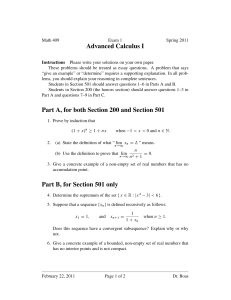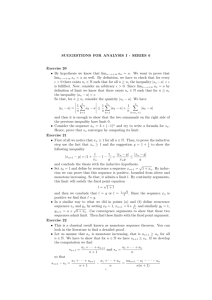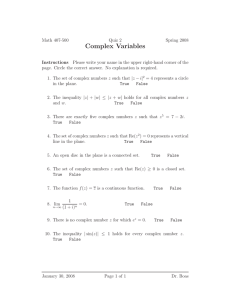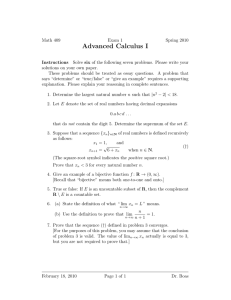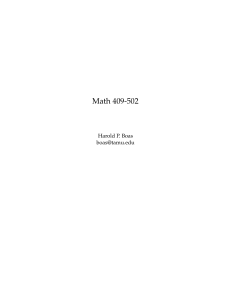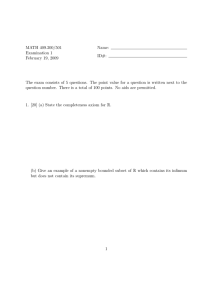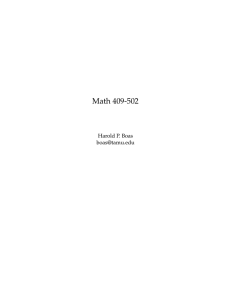Advanced Calculus I
advertisement
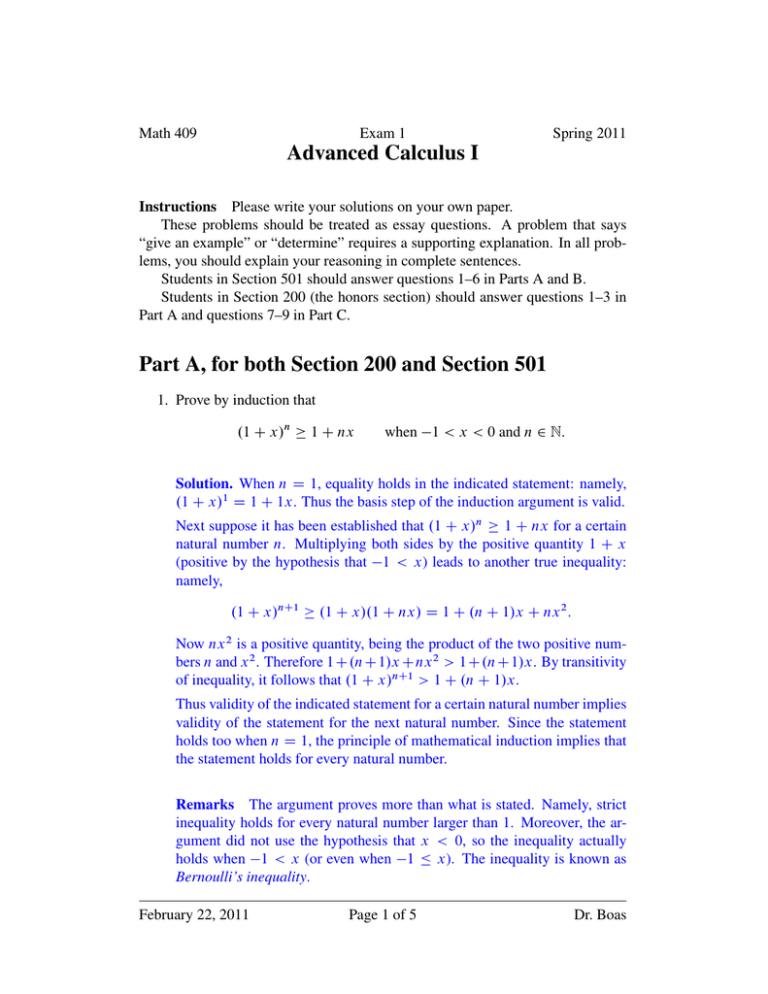
Math 409 Exam 1 Spring 2011 Advanced Calculus I Instructions Please write your solutions on your own paper. These problems should be treated as essay questions. A problem that says “give an example” or “determine” requires a supporting explanation. In all problems, you should explain your reasoning in complete sentences. Students in Section 501 should answer questions 1–6 in Parts A and B. Students in Section 200 (the honors section) should answer questions 1–3 in Part A and questions 7–9 in Part C. Part A, for both Section 200 and Section 501 1. Prove by induction that .1 C x/n 1 C nx when 1 < x < 0 and n 2 N. Solution. When n D 1, equality holds in the indicated statement: namely, .1 C x/1 D 1 C 1x. Thus the basis step of the induction argument is valid. Next suppose it has been established that .1 C x/n 1 C nx for a certain natural number n. Multiplying both sides by the positive quantity 1 C x (positive by the hypothesis that 1 < x) leads to another true inequality: namely, .1 C x/nC1 .1 C x/.1 C nx/ D 1 C .n C 1/x C nx 2 : Now nx 2 is a positive quantity, being the product of the two positive numbers n and x 2 . Therefore 1C.nC1/x Cnx 2 > 1C.nC1/x. By transitivity of inequality, it follows that .1 C x/nC1 > 1 C .n C 1/x. Thus validity of the indicated statement for a certain natural number implies validity of the statement for the next natural number. Since the statement holds too when n D 1, the principle of mathematical induction implies that the statement holds for every natural number. Remarks The argument proves more than what is stated. Namely, strict inequality holds for every natural number larger than 1. Moreover, the argument did not use the hypothesis that x < 0, so the inequality actually holds when 1 < x (or even when 1 x). The inequality is known as Bernoulli’s inequality. February 22, 2011 Page 1 of 5 Dr. Boas Math 409 Exam 1 Spring 2011 Advanced Calculus I 2. (a) State the definition of what “ lim xn D L ” means. n!1 Solution. For every positive real number ", there exists a natural number N such that jxn Lj < " when n N . n (b) Use the definition to prove that lim 2 D 0. n!1 n C 1 Solution. Suppose " is an arbitrary positive real number. Take N to be d1="e (a value that I determined by a side calculation). Here is the verification that this value of N satisfies the definition. (Notice that L D 0 in this problem.) If n N , then n n < (a smaller denominator means a larger fraction) n2 C 1 n2 1 1 D n N 1 (a smaller denominator means a larger fraction) 1=" D ": ˇ ˇ ˇ n ˇ n ˇ Thus ˇ 2 0ˇˇ D 2 < " when n N . Accordingly, the n C1 n C1 value of the limit has been verified by the definition of limit. 3. Give a concrete example of a non-empty set of real numbers that has no accumulation point. Solution. Every neighborhood of an accumulation point has to contain infinitely many elements of the set. Therefore a finite set has no accumulation point. The simplest concrete example of a finite set is a singleton set, such as f5g. An example of an infinite set with no accumulation point is N, the set of natural numbers. This set has no accumulation point because a neighborhood of width 1=3 contains at most one natural number. On the other hand, the Bolzano–Weierstrass theorem implies that every bounded infinite set does have an accumulation point. February 22, 2011 Page 2 of 5 Dr. Boas Math 409 Exam 1 Spring 2011 Advanced Calculus I Part B, for Section 501 only 4. Determine the supremum of the set f x 2 R W jx 2 3j < 6 g. Solution. The indicated inequality means that 6 < x 2 3 < 6, or, equivalently, 3 < x 2 < 9. The left-hand part of the inequality is vacuous, since x 2 is never negative. Therefore the inequality reduces to the statement that x 2 < 9, or 3 < x < 3. The supremum (least upper bound) of the set of such numbers is equal to 3; the infimum equals 3. 5. Suppose that a sequence fxn g is defined recursively as follows: x1 D 1; and xnC1 D 1 1 C xn when n 1. Does this sequence have a convergent subsequence? Explain why or why not. Solution. Evidently all the terms of the sequence are positive numbers. (Namely, the first term is positive, and if xn is positive, then so is 1 C xn and so is the reciprocal 1=.1 C xn /; by induction, all the terms of the sequence are positive.) Therefore 1 C xn > 1, and the reciprocal, which equals xnC1 , is less than 1. In other words, this sequence is bounded: all the terms lie between 0 and 1. By the Bolzano–Weierstrass theorem, there is a convergent subsequence. Remark Actually, this sequence converges, so every subsequence is convergent (and to the same limit). But to prove convergence of the whole sequence is a bit tricky. The subsequence fx2n g is increasing, while the subsequence fx2nC1 g is decreasing, and it turns out that these two monotonic sequences converge to the same limit. The problem is related to the sequence of Fibonacci numbers 1, 1, 2, 3, 5, 8, 13, . . . , each term being the sum of the preceding two terms. The sequence in the problem starts 1, 1=2, 2=3, 3=5, 5=8, 8=13, 13=21, . . . . These fractions are ratios of consecutive Fibonacci numbers. The limit of p these ratios turns out to be . 1 C 5 /=2. February 22, 2011 Page 3 of 5 Dr. Boas Math 409 Exam 1 Spring 2011 Advanced Calculus I 6. Give a concrete example of a bounded, non-empty set of real numbers that has no interior points and is not compact. Solution. A compact set is both closed and bounded. To produce a bounded noncompact set, then, you need to look at sets that fail to be closed, that is, sets that fail to contain some accumulation point. The simplest conceivable example is a convergent sequence that does not contain its limit. A concrete example is the sequence f1=ng consisting of reciprocals of natural numbers. The set is bounded since each number 1=n is between 0 and 1; each point of the set is isolated; and the limit 0 is not in the set. Part C, for Section 200 only 7. (a) When E is a countable set of real numbers, is the complementary set R n E always uncountable? (b) When E is an uncountable set of real numbers, is the complementary set R n E always countable? Explain why or why not. Solution. (a) The union of two countable sets is countable. Consequently, if E is countable, then R n E must be uncountable, for otherwise the union of these two sets, which is all of R, would be countable. But R is uncountable. (b) On the other hand, if E D . 1; 0/, then both E and R n E are uncountable. ˇ ˇ 8. Does the limit superior respect absolute value? In other words, is ˇlim sup xn ˇ n!1 always equal to lim sup jxn j when fxn g is a sequence of real numbers? Prove n!1 or give a counterexample, whichever is appropriate. February 22, 2011 Page 4 of 5 Dr. Boas Math 409 Exam 1 Spring 2011 Advanced Calculus I Solution. Counterexample: If ( xn D 1; 2; when n is even; when n is odd; then lim supn!1 xn D 1, so j lim supn!1 xn j D 1. On the other hand, lim supn!1 jxn j D 2. 9. Consider the following property that a set E of real numbers might or might not have: Whenever a family of closed sets covers the set E, some finite subcollection of those closed sets covers E. (The Heine–Borel property is the corresponding statement for coverings by open sets.) Is this new covering property equivalent to compactness? Explain. Solution. The property is not equivalent to compactness. Indeed, the closed interval Œ0; 1 is compact but lacks the indicated property. Consider the collection of closed intervals f Œ1=n; 1 W n 2 N g together with Œ 1; 0. This family of closed sets covers Œ0; 1, but no finite subfamily covers Œ0; 1. Remark The only sets that have the indicated covering property are finite sets! Indeed, an unbounded infinite set is covered by the family of closed sets f Œ n; n W n 2 N g, and no finite subfamily covers an unbounded set. The Bolzano–Weierstrass theorem implies that a bounded infinite set has an accumulation point, call it c. The family of closed sets consisting of f x 2 R W jx cj 1=n g for each natural number n together with the singleton set fcg forms a cover of R, yet no finite subfamily covers a set that has c as an accumulation point. February 22, 2011 Page 5 of 5 Dr. Boas
